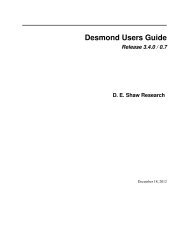Desmond Tutorial
Desmond Tutorial - DE Shaw Research
Desmond Tutorial - DE Shaw Research
- No tags were found...
You also want an ePaper? Increase the reach of your titles
YUMPU automatically turns print PDFs into web optimized ePapers that Google loves.
9 Analyzing Trajectories Using<br />
VMD<br />
Overview<br />
<strong>Desmond</strong> provides extensions to VMD that facilitate trajectory analysis. VMD is primarily<br />
a molecular visualization program, but it is a natural environment for analysis with its<br />
strong support for atom selections, the ability to efficiently animate trajectories that contain<br />
thousands of snapshots, and support for Tcl and Python scripting languages.<br />
This section assumes a Unix/Linux environment and basic familiarity with VMD. If youʹre<br />
just getting started with VMD, a number of excellent tutorials already exist and can be<br />
found on the VMD home page:<br />
http://www.ks.uiuc.edu/Research/vmd/current/docs.html#tutorials<br />
The VMD Python Interface<br />
The Python interface can be accessed from either the console (the terminal from which<br />
you launched VMD), or from an Idle window that runs inside of VMD (preferred). To initiate<br />
the Python interface in the console, simply type gopython at the vmd> prompt. To<br />
launch the built‐in Idle window, youʹll need to set your PYTHONPATH properly as<br />
described in the <strong>Desmond</strong> installation instructions.<br />
The console command to launch the Idle window is<br />
gopython -command "import vmdidle; vmdidle.start()"<br />
You may wish to copy this command into your .vmdrc so that you open this window<br />
every time you launch VMD. Once you have a Python prompt at either the console or the<br />
Idle window, youʹre ready to start using the VMD Python interface.<br />
September 2008 D. E. Shaw Research 85






